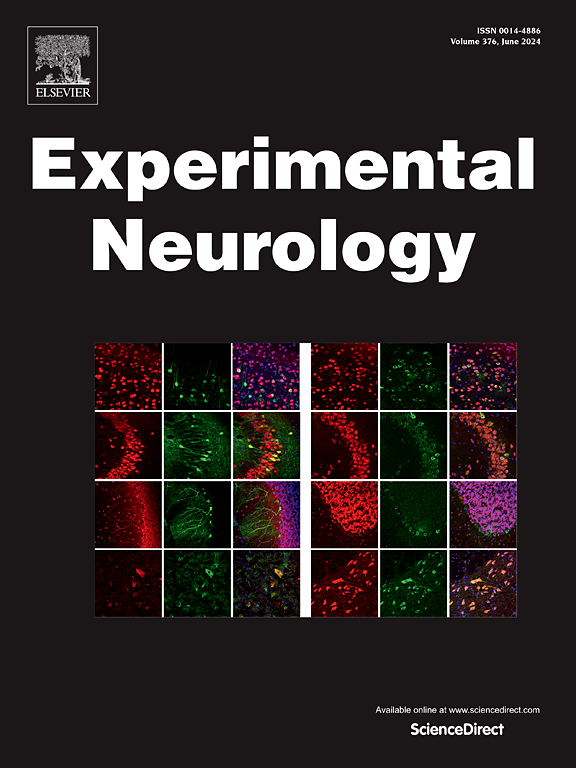去铁胺可减轻海水浸泡合并脑外伤时的铁变态反应。
IF 4.6
2区 医学
Q1 NEUROSCIENCES
引用次数: 0
摘要
创伤性脑损伤(TBI)是全球死亡和残疾的主要原因,海水浸泡可能会加剧其严重性。铁变态反应是由铁依赖性脂质过氧化驱动的一种调节性细胞死亡形式,已被认为与创伤性脑损伤的发病机制有关。然而,在因海水浸泡而加重的创伤性脑损伤的情况下,铁变态反应的具体发生和潜在机制仍不清楚。随后,我们研究了在应用铁螯合剂和铁氧化抑制剂去铁胺(DFO)后海水浸泡对铁氧化的影响,以探索其潜在的治疗价值。我们进行了 RNA 测序、蛋白质表达分析、氧化应激评估、组织病理学检查和行为测试,以全面评估 DFO 对铁沉着病和神经系统结果的影响。我们的研究结果表明,海水浸泡会明显加剧创伤性脑损伤患者的铁沉着病。然而,DFO 治疗可减轻铁蛋白沉积,减轻氧化应激,减少脑组织损伤,提高神经元存活率,促进运动功能恢复。尽管有这些益处,但 DFO 对焦虑、新物体识别以及空间学习和记忆的影响有限。这些研究结果表明,铁蛋白沉积是海水浸泡下创伤性脑损伤的一种新型病理机制,而 DFO 是一种有前途的神经保护剂,能够调节铁蛋白沉积并增强神经功能。这项研究为了解与创伤性脑损伤和海水浸泡相关的复杂损伤情况提供了新的视角,凸显了针对铁蜕变进行治疗干预的潜力。本文章由计算机程序翻译,如有差异,请以英文原文为准。
Deferoxamine alleviates ferroptosis in seawater immersion combined with traumatic brain injury
Traumatic brain injury (TBI) is a major cause of death and disability worldwide, with its severity potentially exacerbated by seawater immersion. Ferroptosis, a form of regulated cell death driven by iron-dependent lipid peroxidation, has been implicated in TBI pathogenesis. However, the specific occurrence and underlying mechanisms of ferroptosis in the context of TBI compounded by seawater immersion remain unclear. Subsequently, we investigated the effects of seawater immersion on ferroptosis after the application of deferoxamine (DFO), an iron chelator and ferroptosis inhibitor, to explore its potential therapeutic value. We conducted RNA sequencing, protein expression analysis, oxidative stress assessment, histopathological examination, and behavioral testing to comprehensively evaluate the impact of DFO on ferroptosis and neurological outcomes. Our results demonstrated that seawater immersion significantly exacerbated ferroptosis in TBI. DFO treatment, however, attenuated ferroptosis, alleviated oxidative stress, reduced brain tissue damage, improved neuronal survival, and promoted motor function recovery. Despite these benefits, DFO exhibited limited effects on anxiety, novel object recognition, and spatial learning and memory. These findings suggest that ferroptosis represents a novel pathological mechanism in TBI under seawater immersion, and that DFO is a promising neuroprotective agent capable of modulating ferroptosis and enhancing neurological function. This study offers new insights into the complex injury conditions associated with TBI and seawater immersion, highlighting the potential of targeting ferroptosis for therapeutic intervention.
求助全文
通过发布文献求助,成功后即可免费获取论文全文。
去求助
来源期刊

Experimental Neurology
医学-神经科学
CiteScore
10.10
自引率
3.80%
发文量
258
审稿时长
42 days
期刊介绍:
Experimental Neurology, a Journal of Neuroscience Research, publishes original research in neuroscience with a particular emphasis on novel findings in neural development, regeneration, plasticity and transplantation. The journal has focused on research concerning basic mechanisms underlying neurological disorders.
 求助内容:
求助内容: 应助结果提醒方式:
应助结果提醒方式:


